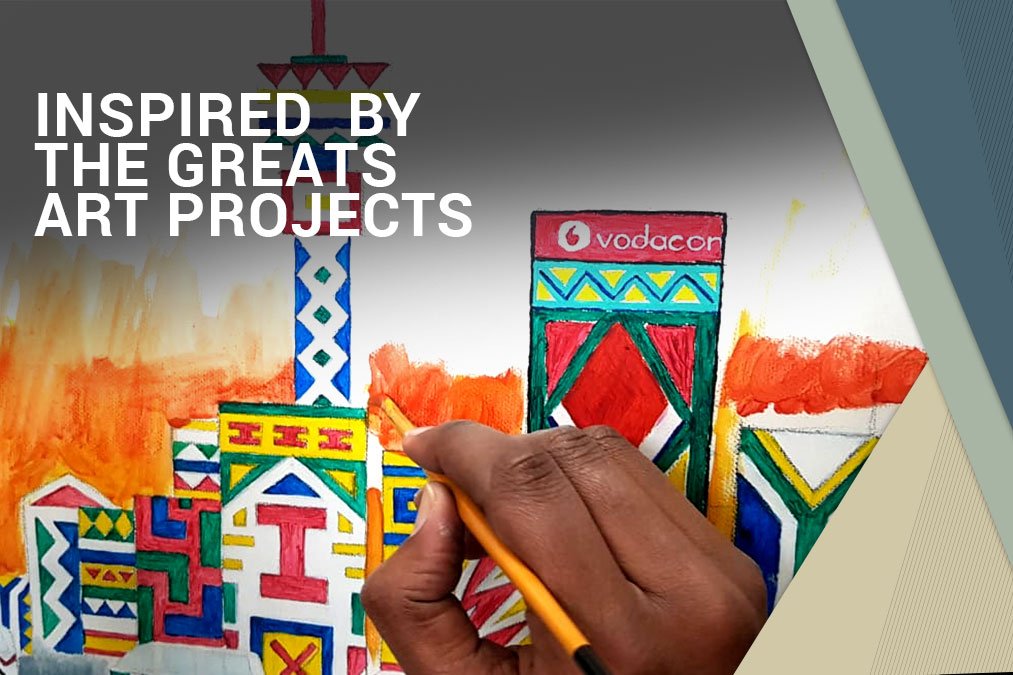No products in the basket.
Our Exhibitions
Inspired by the Greats Projects
ur students will be hosting an Art Exhibition “Inspired by the greats” 28 -September – 1 Oct 2018
This post is for the students of Lillian Gray Art School to brief them on their 8 projects.
Project 1
Cecil Skotnes
Scraperboard
History Lesson: Cecil Skotnes (1926 – 2009) was a South African artist known especially for his painted and incised wooden panels who pioneered a way of producing art that used earth pigments and indigenous wood to construct visual stories about the African past. Full Lesson here.
Brief: Since wood cutting is expensive, we will mimic Skotnes woodcut techniques on scraperboard.
Take a picture you love and transform it into Skotnes’s style. Use bold lines and shapes. Combine various mark making techniques and line qualities.
You will need:
- Scrapeboard
- Sharp scraping tools. You get various nibs for different lines.
- Print out of your reference sketch you made
- White Chalk
- Pencil
- Masking Tape
Pro Tips: Plan with your white chalk on your black scraperboard. Once you start scratching you can’t go back so planning is essential.
Some people have sensory sensitivity. If you cannot handle the sound of scraperboard, use some earplugs. If it feels weird rubber gloves also helps.
Process:
- Take your reference sketch and flip the page over. Cover the back with your chalk entirely.
- Now Stick the page with masking tape onto your scraperboard. (The Print side facing towards you)
- Trace over the printed lines using your pencil. When you remove the page there should be faint chalk lines indicating the drawing on the scraperboard.
Well done! You have now copied your picture onto the scraperboard.
Look carefully at Skotnes’ work. Observe the line quality and mark making techniques. Copy the different lines and areas as best as you can and scarp out the white areas on the scraperboard.
Have fun!
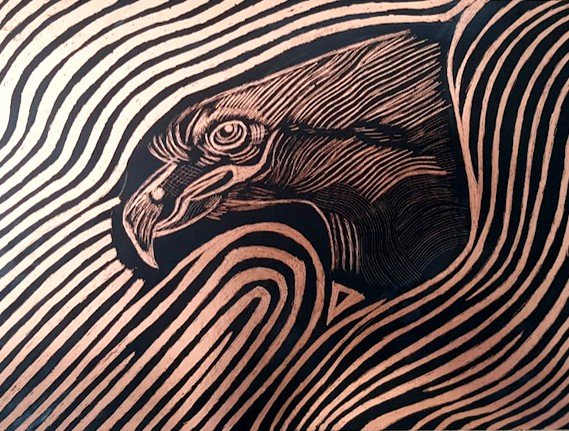
Tony Soares
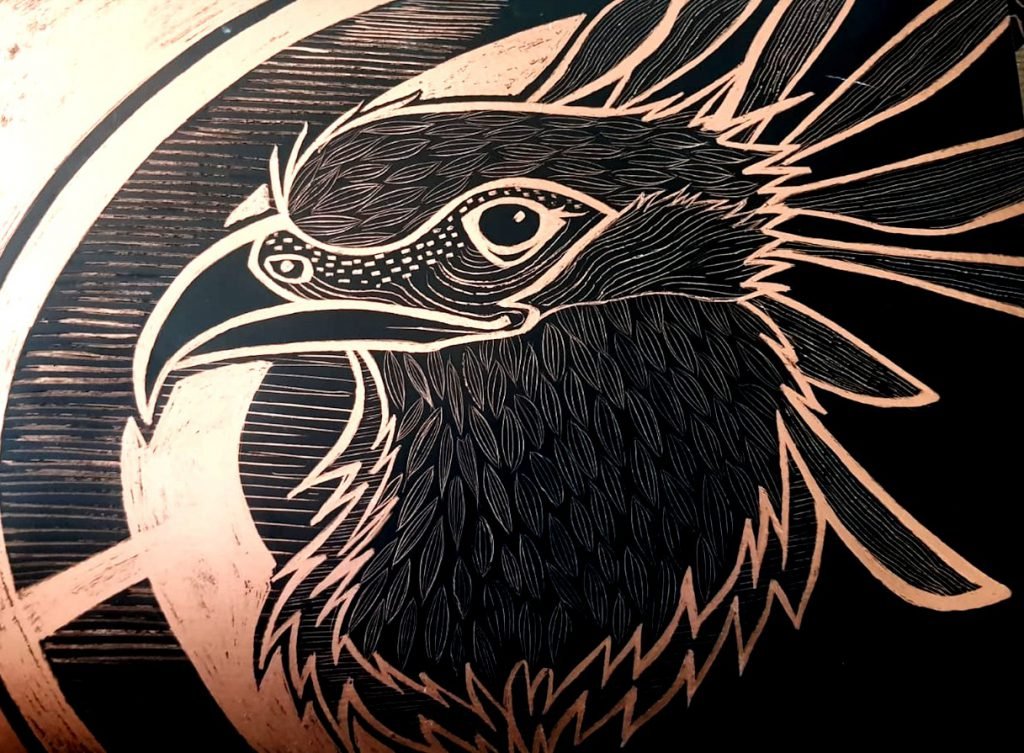
Lillian Gray – Demo
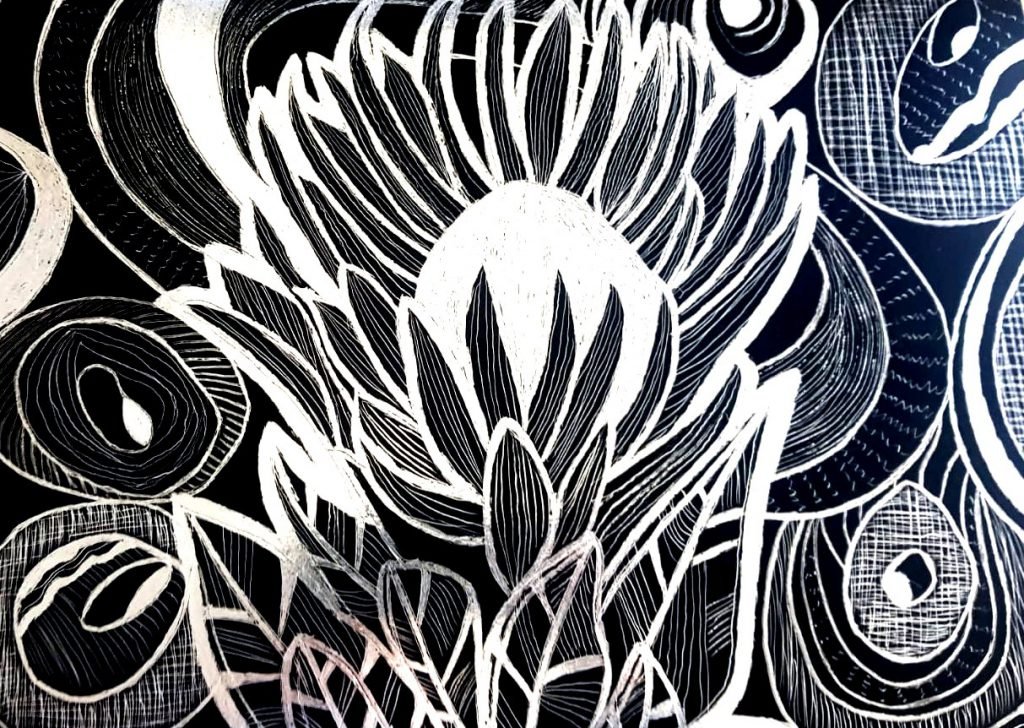
Venetia Howes
Project 2
Salvador Dali
Collage
History Lesson: When we look at Dali’s bizarre paintings filled with dreams, death and decay it truly captures the spirit of the times. We see human figures tearing each other apart, humanity destroying each other. Full Lesson here.
Brief: Find a message you feel strongly about, Global Warming, Trump, Zuma, Protests whatever floats your boat. Simplify this message into one strong concept/idea.
You will need:
- Magazines
- Siccors
- Print / Glue
- Large A2 Paper
Pro Tips: Having quiet areas in your works make it stronger. Do not clutter your collage to much. Rather keep it simple.
Keep your message simple. Remember art is a universal visual language. You need to communicate. Too many messages make the message unclear and vague.
Process:
- Cut out visual elements out of old magazines.
- Stack them all on your page. Remember to plan. If A2 is too big, then go smaller. A3 or even A4.
- First, stick down your background and then your elements at the front.
Have fun!
Project 3
Andy Warhol / Pop Art
Oil painting or Acrylic
History Lesson: Andy’s style of painting is known as POP Art. One of the best known and fun eras in art ever. The name POP Art comes from the word ‘popular’ and draws inspiration from popular media, brands, music and trends. The full lesson here.
Brief: What is your popular culture? Which movies, brands, stars are you drawn to? Black Panther, Katy Perry, Marmite. Pick a popular culture image and paint it in bright colours like Andy Warhol. Check out Andy’s Style. Maybe you want to do only one image or create replicas of the same image but in different colours.
You will need:
- A3 Canvas
- Oil Painting or Acrylic Kit
Pro Tips: Lots of bright colours. Use complimentary colours with high contrast to really make your work POP. (No pun intended)
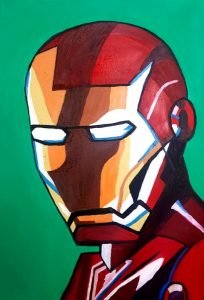
Tatyana Jhagaroo
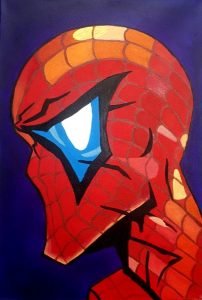
Tatyana Jhagaroo
Project 4
Irma Stern
Acrylic or Oil Paint on Canvas
History Lesson: Irma Stern gradually won acceptance and eventually acclaim. Her strong interest in portraying black people was also a point of public controversy, especially in the 1930s. The full lesson here.
Brief: Find a picture of a face you like. Would be great if it could be somebody society doesn’t usually value (Security guards, parking attendants, tellers) and paint it in Irma Stern’s style. Loose big rough brush strokes.
You will need:
- A3 Canvas
- Acrylic of Oil Painting Kit
- Pencil
Pro Tips: Try and paint fast. When you have a time limit you tend to work looser. Be free.

Kara Voster
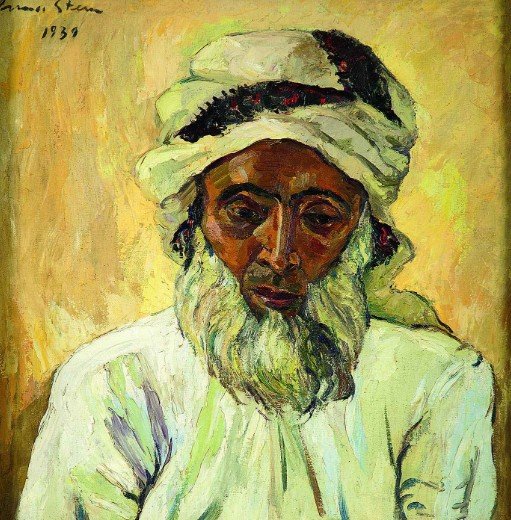
Demo
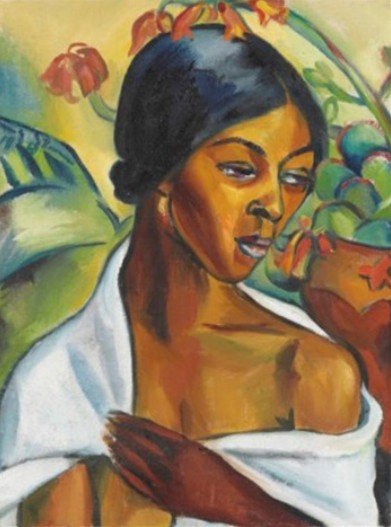
Demo
Project 5
Pierneef
Acrylic or Oil Paint on Canvas
History Lesson: Jacobus Hendrik Pierneef was a South African landscape artist, generally considered to be one of the best of the old South African masters. His distinctive style is widely recognised and his work was greatly influenced by the South African landscape. Full lesson here
Brief: This project is concerned with Pierneef’s later works. His abstract phase. During this time Pierneef broke down his landscapes into geometric forms.
Find a photo of a landscape that you like and convert it to modern geometric shapes.
You will need:
- A3 Canvas
- Acrylic of Oil Painting Kit
- Pencil
Pro Tips: Simplify, simplify, simplify. Don’t over complicate it. Imagine the landscape is cut out of coloured cardboard paper. Identify the main areas in the landscape. Example 1. Mountain, Sky, Ground & Tree. Find the local colours for all these. Example. The mountain is brown. Mix 3 browns. A dark brown, a light brown and middle brown. Brake the mountain into triangles. Now fill the triangles with these 3 browns. Boom! Mountain done!

Jeanine Price
Pierneef
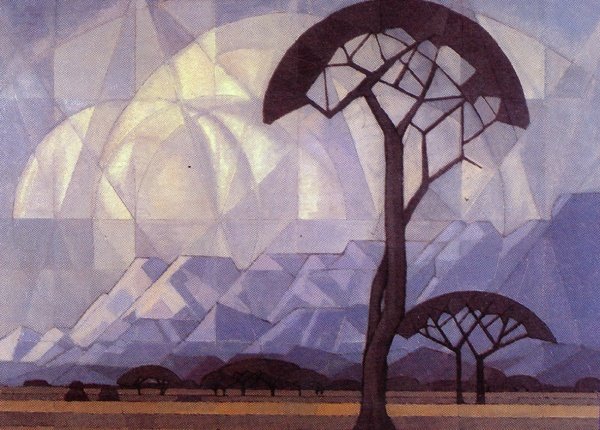
Pierneef
Project 6
William Kentridge
Charcoal
History Lesson: William Kentridge is a South African artist and filmmaker. Best known for his animated drawings, the central focus of Kentridge’s oeuvre has been to examine the years before and after apartheid. Full Lesson here.
Brief: Find a room and draw the room from life using charcoal. You can add one colour with a soft pastel either red or blue.
You will need:
- A2 Paper Board 160gms
- Raw/Willow Charcoal
- Soft, Medium, Hard Charcoal.
- Charcoal Pencils.
Pro Tips: Careful with the red pastel. It can soon turn into a horror movie and resemble blood.
Choose a nice corner. Using a room with angels makes the drawing more interesting.
Process:
- Position your station and room at eye level. Remember your vanishing points and start drawing with a raw charcoal.
- Make charcoal powder using raw and build up your darker areas.
- Now start adding even more darks using soft charcoal.
- Add more contrast with Medium and Soft Charcoal
- Add fine lines with your Charcoal Pencils or Hard Charcoal.
- Add your final focus colour with a soft pastel.

William Kentridge
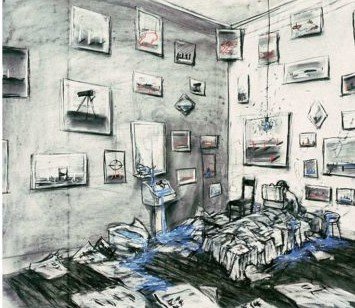
William Kentridge
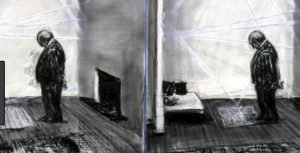
William Kentridge
Project 7
Esther Mahlangu
Acrylic on Canvas
History Lesson: A leading South African artist is on a mission to preserve her culture through her world-renowned creations. 81-year-old Esther Mahlangu has been painting since she was 10 years old. She is known for bold, large-scale artworks that reference her Ndebele heritage. Full Lesson here.
Brief: Pick one of your favourite things. (Your favourite animal, favourite musical instrument, favourite hobby) and find a nice reference for it. Now cover that object in Ndebele patterns.
You will need:
- A3 Canvas
- Pencil
- A wide range of Acrylic paint colours.
- Small brushes
Pro Tips: Look closely at the Ndebele patterns they are different to other African tribes. They are symmetrical in designs but not in colour. They are a bit more complex than you think. Also look at Esther’s colour use. She doesn’t always use African colours but also modern pinks, teals and mint.
Process:
- Draw your favourite item on your canvas. Keep it nice and big. If you draw it too small your patterns will be even smaller and harder to paint.
- Start painting filling in your patterns. It works best if you add the black outlines last. Then your colours won’t become dirty.
- A dark black background also makes your item ‘pop’ and stand out
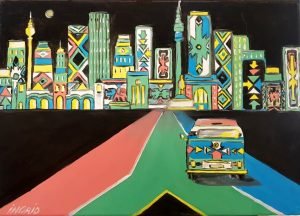
Ingrid Artus
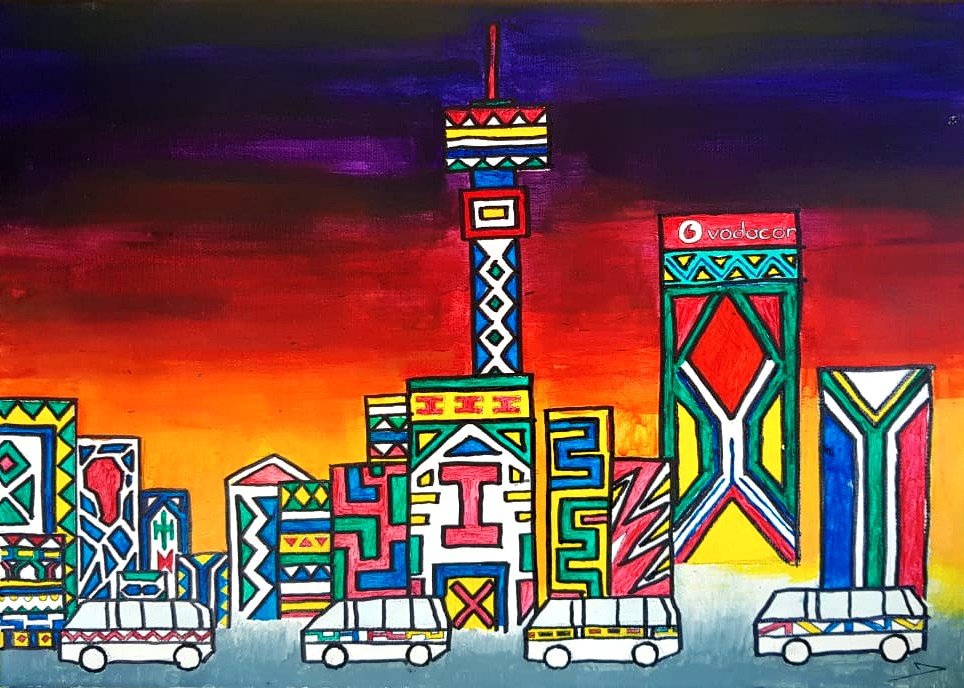
Nadeem Hoosen
Project 8
Toulouse-Lautrec
Oil Pastel on Board
History Lesson: Copious amounts of money, not accepted by his father, deformed, unnaturally short, lover of reading and knowledge, highly skilled and gifted, drawn to the woman and drinking…NO I am not talking about Tyrion Lannister, I am talking about Henri de Toulouse- Lautrec. An extremely gifted artist with a sad story. The full lesson here.
Brief: Toulouse was poor at the end of his life (once his father cut off his allowance) so he often used cardboard to draw sketches on. To mimic the cardboard feeling we will first cover our page with soft pastels in brown colours. Then we switch to oil pastels to draw the sketch on.
Take a picture you love and transform it into Toulouse’s style. Quick moving lines (gesture drawing) with wonderful marks. Hatching and flicks of colour.
You will need:
- Whiteboard paper 160gms. If you want to spend money buy brown kraft board to work on then you can skip the soft pastel step.
- Brown soft pastel. (If you are working on whiteboard paper.)
- Print out of your reference. Since Toulouse drew dancers, cabaret and circus act, try sticking to this theme. Maybe a modern spin on it would be cool?
- Oil Pastels
Pro Tips: It helps to first copy a sketch of Toulouse to familiarise yourself with his styles and techniques. It would then be easier to apply it to your own interpretation.
Process:
- Take your white page and cover it with soft brown pastel. Smooth it with some paper towel. Your page should have a lovely brown texture to work on.
- With a pencil lightly draw out your sketch.
- Start drawing now using oil pastels. Remember to leave some of the brown background shining through.
- You can ‘mix’ pastels by smudging them on the page and blending them together.

Jeanine Price

Jeanine Price

Ingrid Artus
DEADLINE FOR ALL PROJECTS 18 SEPTEMBER 2018 20:00
Please note that all artists are responsible to get their projects ready to hang for the exhibition. This means either framed or on a box canvas so we can hang it.

